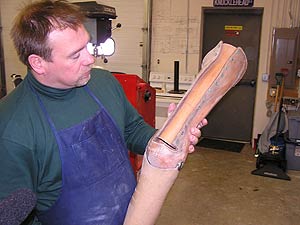|
Audio
Photos
|
 |
| Ken Heide says wooden limbs are popular with elderly patients. (MPR Photo/Bob Reha) |
Moorhead Minn. — Ken Heide stands in front of an antique radio in the lobby of his office, the walls are decorated with all kinds of antiques. There are golf clubs, hockey sticks and tennis rackets, but no examples of his own work. Heide owns Regional Artificial Limb and Brace Company in Fargo, and part of his job is to carve wooden limbs.
"Some of the older patients who've always had wood will stick with wood," he says. "The theory is, if they come in with a certain type or design you stay with it, unless they're willing to change. Once you start out with a prosthesis, if you start out with a wooden, artificial limb, it's very difficult to change those people out to something different."
Cost is also a consideration for some people. Newer artificial limbs that are more technologically advanced can cost up to $70,000. Wooden limbs may cost up to $5,000.
Heide picks up a large block of wood, there are handwritten measurements jotted on the side. This wood will become a socket, which will be used to fit a patient for a limb.
"Once the socket is fit to where the patient is comfortable in the socket, then what we do is take the wooden block and start shaping the corners," says Heide. "We start shaping it to look like a thigh, so this is what we start with in the beginning is a basic block."
Many of the tools Heide uses are handmade. Some were used by Heide's father and brother, who are also carvers, both are semi-retired.
"We use some draw knifes, where you can actually put the wooden block between your legs and you have a set of draw knifes and they will dig into the wood and pull up," says Heide. "We use some hand routers, we also have electric routers, but a lot of it is specialty hand tools, they're wood working tools that you actually get in there and chisel away some of the wood."
Heide says over the years he's had some special requests. One woman had a fish net stocking embossed on her wooden leg and a Native-American man who is a dancer, had tribal symbols painted on his.
Heide says some people in the business specialize, like a carver he knows in Kansas.
"He used to do hand carved feet and he actually had a display rack that he would show me. These are the four feet that he could carve for you out of a wooden block and he could carve it right down to the toenails. That was fantastic to see," says Heide. "That was his trade-secret., You wanted a foot - he wasn't going to show how to make it. But if you came to him, he'd make you one and that's where everyone has his little secrets."
Heide says, the work is a combination of health care and art, with a lot of stress thrown in for good measure.
"You know, you're trying to please too many people. From the patient on the leg, to the family members, to the physician to the insurance carrier. And it's all got to be done tomorrow," says Heide.
Heide jokes, there have been days when he's fired himself several times, but he always comes back to work.
"It's the gratification from the fact that I can take somebody who is in dire need to improve on their lives and I can make that improvement," says Heide.
Heide says he can't come to work with a bad attitude, because the customers he sees have problems that make his seem insignificant.






